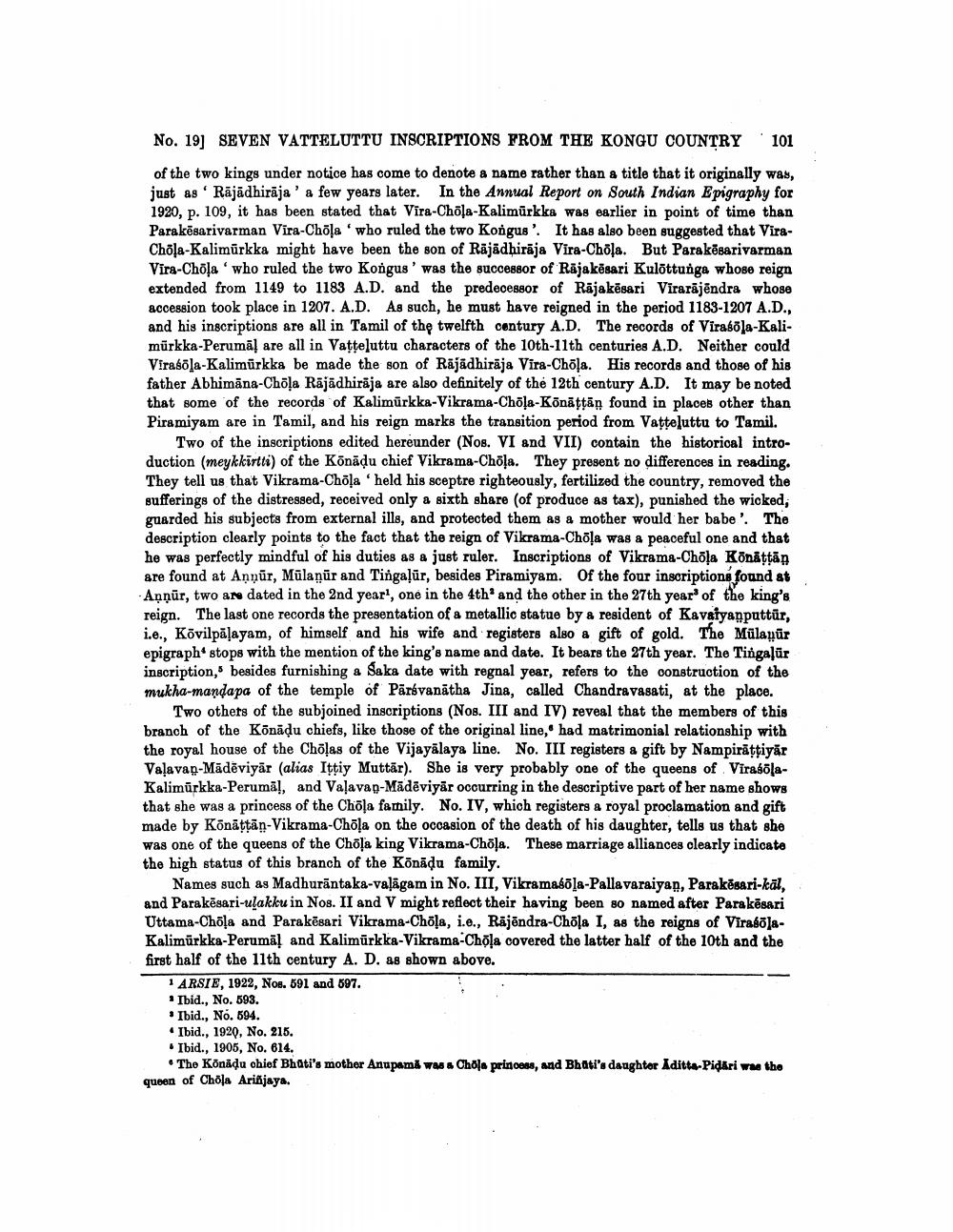________________
No. 19] SEVEN VATTELUTTU INSCRIPTIONS FROM THE KONGU COUNTRY '101
of the two kings under notice has come to denote a name rather than a title that it originally was, just as Rājādhirāja' a few years later. In the Annual Report on South Indian Epigraphy for 1920, p. 109, it has been stated that Vira-Chõla-Kalimūrkka was earlier in point of time than Parakēsarivarman Vira-Chola' who ruled the two Kongus'. It has also been suggested that ViraChola-Kalimūrkka might have been the son of Rājādhirāja Vira-Chola. But Parakēsarivarman Vira-Chola who ruled the two Kongus' was the successor of Rajakesari Kulottunga whose reign extended from 1149 to 1183 A.D. and the predecessor of Räjakësari Virarājēndra whose accession took place in 1207. A.D. As such, he must have reigned in the period 1183-1207 A.D., and his inscriptions are all in Tamil of the twelfth century A.D. The records of Virabola-Kalimūrkka-Perumal are all in Vatteluttu characters of the 10th-11th centuries A.D. Neither could Virabola-Kalimürkka be made the son of Rājádhirāja Vira-Chola. His records and those of his father Abhimāna-Chöļa Rājādhirāja are also definitely of the 12th century A.D. It may be noted that some of the records of Kalimūrkka-Vikrama-Chēļa-Kõnātā found in places other than Piramiyam are in Tamil, and his reign marks the transition period from Vatteluttu to Tamil.
Two of the inscriptions edited hereunder (Nos. VI and VII) contain the historical introduction (meykkirtti) of the Könādu chief Vikrama-Chõļa. They present no differences in reading. They tell us that Vikrama-Chola held his sceptre righteously, fertilized the country, removed the sufferings of the distressed, received only a sixth share (of produce as tax), punished the wicked, guarded his subjects from external ills, and protected them as a mother would her babe'. The description clearly points to the fact that the reign of Vikrama-Choļs was a peaceful one and that he was perfectly mindful of his duties as a just ruler. Inscriptions of Vikrama-Chola Konattan are found at Aņņūr, Mülaņūr and Tingaļūr, besides Piramiyam. Of the four inscriptions found at Annür, two an dated in the 2nd year, one in the 4th and the other in the 27th year of the king's reign. The last one records the presentation of a metallic statue by a resident of Kavaiyanputtür, i.e., Kovilpāļayam, of himself and his wife and registers also a gift of gold. The Mülayūr epigraph stops with the mention of the king's name and date. It bears the 27th year. The Tingalur inscription, besides furnishing a Saka date with regnal year, refers to the construction of the mukha-mandapa of the temple of Pārsvanātha Jina, called Chandravasati, at the place.
Two others of the subjoined inscriptions (Nos. III and IV) reveal that the members of this branch of the Könādu chiefs, like those of the original line, had matrimonial relationship with the royal house of the Cholas of the Vijayālaya line. No. III registers a gift by Nampirāttiyar Vaļavan-Mādēviyār (alias Ittiy Muttār). She is very probably one of the queens of VirasolaKalimürkka-Perumal, and Vaļavap-Mādēviyār occurring in the descriptive part of her name shows that she was a princess of the Chola family. No. IV, which registers a royal proclamation and gift made by Kõnāttān-Vikrama-Chöļa on the occasion of the death of his daughter, tells us that she was one of the queens of the Chola king Vikrama-Chöļa. These marriage alliances clearly indicate the high status of this branch of the Könādu family.
Names such as Madhurāntaka-vaļāgam in No. III, Vikramaśāla-Pallavaraiyan, Parakēsari-kal, and Parakēsari-ulakku in Nos. II and V might reflect their having been so named after Parakēsari Uttama Chola and Parakësari Vikrama-Chola, i.e., Räjëndra-Chöla I, as the reigns of VirabolaKalimūrkka-Perumal and Kalimürkka-Vikrama-Chola covered the latter half of the 10th and the first half of the 11th century A. D. as shown above.
1 ARSIE, 1922, Nos. 591 and 697. . Ibid., No. 593. . Ibid., No. 594. • Ibid., 1920, No. 215. • Ibid., 1905, No. 614.
• The Kõnadu ohiof Bhati's mother Anupama was a Chola princess, and Bhati's daughter Aditta-Pidari was the queen of Chöļa Ariñjaya.




